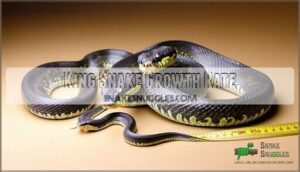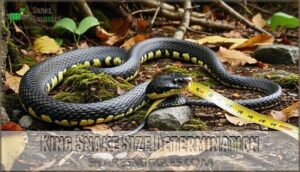This site is supported by our readers. We may earn a commission, at no cost to you, if you purchase through links.
 King snakes typically reach 3-5 feet long and achieve full size within 3-4 years. You’ll see the most dramatic growth during their first year when they double in size at roughly 2 inches per month. Hatchlings start tiny at 8-12 inches, but this rapid pace slows substantially after year two as they focus on building muscle mass rather than length.
King snakes typically reach 3-5 feet long and achieve full size within 3-4 years. You’ll see the most dramatic growth during their first year when they double in size at roughly 2 inches per month. Hatchlings start tiny at 8-12 inches, but this rapid pace slows substantially after year two as they focus on building muscle mass rather than length.
California kingsnakes usually max out around 4 feet, while Eastern varieties can stretch to 4.5 feet, with occasional specimens hitting 6-7 feet. Females often outgrow males due to natural size differences. Proper feeding schedules, adequate habitat space, and ideal temperature control directly impact how quickly your snake reaches its genetic potential.
Table Of Contents
- Key Takeaways
- How Long Do King Snakes Get and How Long It Takes to Grow?
- King Snake Growth Rate
- King Snake Size at Birth
- King Snake Growth in First Year
- King Snake Growth in Second Year
- King Snake Maximum Length
- Factors Affecting King Snake Growth
- King Snake Age Estimation
- King Snake Size Determination
- Importance of Knowing King Snake Size
- King Snakes for Sale and Size Considerations
- Frequently Asked Questions (FAQs)
- How big are king snakes at birth?
- How quickly do king snakes grow in their first year?
- What factors influence king snake growth?
- How old is a king snake when it reaches its maximum length?
- How can I estimate the age of a king snake?
- Do male and female king snakes differ in size?
- Can king snakes continue growing after maturity?
- How to measure king snake length accurately?
- What health problems affect king snake growth?
- Conclusion
Key Takeaways
- Your king snake will reach 3-5 feet in length and achieve full size within 3-4 years, with California kingsnakes typically maxing out around 4 feet, while Eastern varieties can stretch to 6-7 feet.
- You’ll see explosive growth in the first year, when hatchlings double their 8-12 inch birth size, growing at roughly 2 inches per month, before the pace slows significantly after year two.
- Proper feeding schedules, adequate habitat space, and ideal temperature control directly impact how quickly your snake reaches its genetic potential, making consistent care essential for healthy development.
- Females often outgrow males due to natural size differences, and you can estimate your snake’s age by measuring its length against species-specific growth milestones, since most reach sexual maturity between 2-4 years.
How Long Do King Snakes Get and How Long It Takes to Grow?
King snakes reach their maximum recorded length of 3-6 feet through predictable growth milestones. You’ll see rapid size variations during their first year, when genetic traits and dietary needs substantially impact their growth rate.
Environmental factors like temperature and habitat quality influence how quickly your snake reaches its average length of 4 feet, typically achieved within 3-4 years of consistent care.
King Snake Growth Rate
When tracking King Snake Growth patterns, you’ll find these serpents develop at a remarkably consistent pace. Growth rate averages 2 inches monthly during their active development period, with Snake Growth Rates influenced by several key variables.
Development Stages reveal fascinating growth patterns – juveniles double their original size within twelve months, creating dramatic visual changes. Nutrition Impact plays a vital role, as well-fed specimens consistently outpace their undernourished counterparts. Environmental Effects like temperature regulation and habitat space directly correlate with growth velocity.
Size Factors include species genetics, gender differences, and seasonal variations that affect metabolic rates. Males typically grow faster initially but females often achieve greater final lengths. King Snake Size progression follows predictable milestones, making it easier to estimate age and plan care requirements.
Understanding these growth patterns helps you prepare appropriate enclosures and feeding schedules. Each snake’s individual growth trajectory may vary slightly, but consistent monitoring reveals whether your specimen is developing within normal parameters for healthy and longevity.
King Snake Size at Birth
Your new king snake hatchling arrives as a tiny, perfectly formed serpent ready to start its growth journey. Understanding Neonate Size helps you provide proper care from day one.
Hatchling Length typically ranges from 8-12 inches, though this varies by species:
- California kingsnakes measure 8-12 inches at birth
- Scarlet kingsnakes range from 3.1-7.1 inches (8-18 cm)
- Smaller subspecies start around 4 inches, while larger varieties reach 12 inches
These newborn development measurements represent your snake’s genetic blueprint. Birth Weight remains minimal, with hatchlings appearing slender at roughly 1/4 inch thick. Their vibrant juvenile coloring often differs dramatically from adult patterns.
Initial Growth depends on species genetics and environmental conditions during incubation. Temperature and humidity influence King Snake Size at hatching. Your hatchling’s Average Length falls within these ranges, but individual variation occurs naturally. Unlike many reptiles, king snake babies emerge fully independent, capable of hunting newborn mice immediately after their first shed. To provide proper care, research kingsnake care guidelines for your pet.
King Snake Growth in First Year
Your hatchling’s first year represents its most explosive growth period, transforming from a tiny 8-13 inch newborn into a robust juvenile measuring 23-27 inches. During this remarkable developmental phase, king snakes double their birth length and often triple their weight, reaching approximately 75 grams by their first birthday. The ease of care contributes to their popularity as pets.
King snakes experience explosive first-year growth, doubling their birth length within twelve months
Proper Juvenile Care during this critical window requires:
- Consistent feeding schedules – offer appropriately sized rodents every 5-7 days to fuel rapid Hatchling Development
- Optimal environmental conditions – maintain proper temperature gradients and humidity levels for maximum growth rate
- Quality nutrition – whole prey items provide essential nutrients supporting healthy Growth Patterns
Your snake’s genetics influence its specific Growth Patterns, so research your subspecies’ typical hatchling size expectations. California kingsnakes fed twice weekly grow substantially faster than those fed once, demonstrating how Feeding Schedules directly impact King Snake Growth. Early Nutrition choices you make now establish the foundation for your snake’s lifelong health and eventual King Snake Size potential.
King Snake Growth in Second Year
During their second year, your king snake’s growth rate remains impressive but begins to stabilize. Most California kingsnakes reach 36-40 inches by their second birthday, effectively doubling their year-one size. This development rate represents substantial size increase from the rapid juvenile Snake Growth Patterns of earlier months.
Your snake’s maturation process becomes more predictable during these Second Year Milestones. Weight typically ranges from 190-400 grams, depending on feeding consistency and genetics. The monthly growth rate slows to approximately one inch per month as King Snake Growth approaches sub-adult dimensions.
King Snake Size variations become apparent during this period. Males often reach sexual maturity by year two, while females need additional time. Growth Patterns shift from pure length increases to developing muscle mass and girth. Environmental factors like temperature and nutrition continue influencing King Snakes Growth markedly during this pivotal developmental stage. Proper diet and feeding techniques are essential for supporting healthy growth and development in king snakes, focusing on King Snake Diet and overall King Snake care.
King Snake Maximum Length
After that second-year growth spurt, you’re probably wondering just how big your king snake will get. Most king snakes reach their maximum recorded length between 3-5 feet, though size records show some impressive exceptions.
Here’s what you can expect for maximum length across different species:
- Common kingsnakes typically max out at 4 feet, with rare specimens reaching 7 feet
- California kingsnakes usually stay under 4 feet but occasionally hit 5 feet
- Eastern kingsnakes average 3.5-4.5 feet, with exceptional individuals approaching 6 feet
- Desert kingsnake subspecies rarely exceed 4 feet in average length range
Length variations depend heavily on genetics, gender, and regional differences. Females often outgrow males, and species comparisons reveal significant differences in growth patterns. While that 7-footer sounds impressive, remember these giants are extremely rare exceptions to typical king snake size.
Factors Affecting King Snake Growth
Several key factors determine how quickly and how large your king snake will grow. Diet quality, habitat conditions, genetics, and proper care all work together to influence whether your snake reaches its full potential size within the typical 3-4 year timeframe.
Your king snake’s growth depends on what you feed them, where they live, and their genes working together
King Snake Growth Factors
Several factors act like master controllers of your king snake’s development. Genetic Influence sets the blueprint—some species hit 7 feet while others cap at 3 feet.
Environmental Impact through proper temperature and humidity creates ideal Growth Patterns. Dietary Needs fuel King Snake Growth; consistent feeding schedules boost growth rate substantially.
Habitat Requirements including adequate space prevent stunted King Snake Development. Health issues can derail Genetics and Growth potential, making proper care essential for reaching maximum King Snake Size.
Size and Lifespan Variations
King Snake species exhibit distinct Size Genetics and Growth Patterns that vary considerably. Environmental Influences shape development, with colder regions producing larger specimens. Lifespan Factors typically span 10-15 years, though Species Variations affect longevity. Gender dimorphism shows females often exceeding male Average Length, while geographic populations demonstrate unique King Snake Development characteristics.
- Eastern kingsnakes reach exceptional lengths up to 7 feet in ideal conditions
- California subspecies typically max out at 4 feet due to genetic constraints
- Banded color morphs tend to develop stouter body proportions than striped variants
Proper Care and Selection
Creating ideal conditions starts with understanding your snake’s adult potential. Select Enclosure Size based on maximum expected length—most Lampropeltis species need 40+ gallon tanks when fully grown.
| Care Aspect | Juvenile Requirements | Adult Requirements |
|---|---|---|
| Habitat Design | 20-gallon minimum | 40+ gallon tank |
| Dietary Needs | Weekly feeding | Bi-weekly schedule |
| Snake Handling | Gentle, brief sessions | Regular interaction |
Your King Snake Care routine directly impacts growth rate. Proper temperature gradients (75-85°F) and consistent feeding schedules help juveniles reach their Average Length within three years. Remember—King Snake Size varies by subspecies, so research your specific variety’s growth patterns. Quality Care Tips include monitoring weight gain and adjusting prey size accordingly. When setting up your snake’s environment, consider the importance of proper snake enclosure design to guarantee a healthy and thriving pet.
King Snake Age Estimation
Determining your king snake’s age isn’t always straightforward, but understanding Growth Patterns and Development Stages helps narrow down estimates. King Snake Age estimation relies on multiple physical indicators since growth rate varies substantially between individuals.
Age Factors that influence Size Estimation include genetics, diet quality, and environmental conditions. Most king snakes reach sexual Maturity Rates between 2-4 years, providing a reliable milestone. However, Average Length alone won’t give you precise age since some snakes grow faster than others.
Here are reliable methods for King Snake Growth assessment:
- Measure total body length and compare against species-specific growth charts
- Examine shedding frequency patterns (juveniles shed more often)
- Assess sexual maturity indicators and breeding readiness
- Evaluate overall body condition and muscle development
- Consult experienced reptile veterinarians for professional assessment
King Snake Size correlates with age but remember that ideal captive conditions often produce larger snakes than wild counterparts at similar ages. Understanding snake age factors is vital for accurate estimation and care.
King Snake Size Determination
Accurate measurements form the foundation of proper king snake care, directly influencing enclosure size, dietary needs, and handling approaches. You’ll need to measure your snake’s total length from snout to tail tip using a flexible measuring tape while the snake is calm and extended. Regular weighing helps track growth rate and adjust feeding schedules accordingly.
King Snake Size varies substantially due to Species Variance and Genetic Influence. Eastern kingsnakes typically reach 4-6 feet, while California kingsnakes average 3-4 feet. Habitat Effects also play a role – captive snakes often grow larger than wild counterparts due to consistent food availability.
Growth Patterns change dramatically from hatchling size (8-14 inches) to full size (3-5 feet average). Young snakes double their length annually during rapid growth phases, then slow considerably after reaching sexual maturity. Understanding these measurements helps guarantee you’re providing appropriate care throughout your snake’s development.
Importance of Knowing King Snake Size
Understanding your king snake’s dimensions isn’t just helpful—it’s essential for proper reptile stewardship. Snake Habitat Needs directly correlate with your pet’s current measurements and projected full size. Growth Monitoring becomes straightforward when you track their average length range against established growth rate benchmarks.
Here’s why Size Estimation matters for Snake Care Tips:
- Enclosure sizing – A 20-gallon tank suits juveniles, but adults need 40+ gallons based on their final dimensions
- Feeding protocols – Prey diameter should match your snake’s thickest body section for safe consumption
- Temperature gradients – Larger snakes require longer basking areas to thermoregulate effectively
- Veterinary care – Dosages and handling techniques depend on accurate weight and length measurements
Species Variations mean King Snake Size ranges from 2.5 feet (Mountain kingsnakes) to 6+ feet (Eastern subspecies). Without proper measurements, you’re basically flying blind with King Snake Growth management, potentially compromising their health and comfort.
King Snakes for Sale and Size Considerations
When you’re shopping for a king snake, understanding their growth patterns helps you prepare the right enclosure and care plan from day one.
These serpents typically reach 3-5 feet in length over 3-4 years, though some species like Eastern king snakes can stretch up to 6-7 feet with proper nutrition and care plan.
King Snake Size and Growth
King Snake Size varies substantially across subspecies, with genetics determining your snake’s growth potential from day one. Growth Patterns show most kingsnakes reach full size between three to four years, though hatchling size and growth rate depend heavily on Size Genetics and Environmental Effects.
Nutritional Needs directly impact Morphological Changes, making proper feeding schedules essential for King Snake Growth success. Understanding the role of size genetics in king snakes requires knowledge of King Snake Size factors.
Factors Influencing Size
When selecting your king snake, several biological factors shape its ultimate size potential. Genetic Influence from species variation determines whether you’ll have a compact 2.5-foot California kingsnake or a robust 6-foot eastern specimen. Habitat Effects including temperature regulation directly impact growth rate, while proper Dietary Needs guarantee healthy development from hatchling size to full size.
- Species Variation: Different subspecies reach vastly different maximum lengths
- Climate Impact: Warmer temperatures accelerate metabolism and King Snake Growth patterns
- Nutritional Quality: Consistent feeding schedules optimize growth rate and overall King Snake Care
Importance of Knowing Size
When choosing your king snake, Size Estimation directly impacts your preparation and long-term commitment. You’ll need enclosures matching their full size potential—typically 40+ gallons for adults. Growth Patterns determine feeding schedules, shifting from hatchling size prey to adult rodents.
Habitat Needs expand as they grow, requiring larger hides and climbing space. Understanding Growth Rate helps budget for Snake Nutrition costs over their 15-20 year lifespan. Proper Care Guidelines prevent stunted development, ensuring your King Snake Growth reaches its genetic potential through consistent King Snake Care.
Accurate king snake size data is essential for creating suitable king snake habitats to support their development.
Frequently Asked Questions (FAQs)
How big are king snakes at birth?
Like tiny pencils fresh from the box, newborn king snakes hatch at 8-12 inches long.
You’ll find these hatchlings are already perfectly formed miniatures of their parents, ready to hunt and grow rapidly from day one.
How quickly do king snakes grow in their first year?
During their first year, you’ll watch king snakes grow at an impressive rate of approximately 2 inches per month, effectively doubling their original hatchling size by year’s end.
What factors influence king snake growth?
Your snake’s growth depends on diet quality, feeding frequency, temperature regulation, enclosure size, genetics, and overall health. Proper nutrition and warm basking spots accelerate development, while stress stunts growth.
How old is a king snake when it reaches its maximum length?
Most king snakes reach their maximum length between 3-4 years old, though some may take up to 5 years.
You’ll see rapid growth in the first 18 months, then it slows markedly as they approach maturity and full size.
How can I estimate the age of a king snake?
You can estimate a king snake’s age by measuring its length and comparing it to growth milestones. They reach full size around 3-4 years, doubling their hatchling length within the first year.
Do male and female king snakes differ in size?
Like night and day, you’ll notice females typically grow larger than their male counterparts. This sexual dimorphism means females often reach 4-6 feet while males stay around 3-4 feet, with genetics and environment influencing final size.
Can king snakes continue growing after maturity?
Yes, you’ll find that king snakes can continue growing throughout their lives, though it’s minimal after reaching sexual maturity.
This lifelong growth happens slowly compared to their rapid juvenile development phases.
How to measure king snake length accurately?
Gently straighten your snake along a measuring tape or ruler, supporting its body every few inches.
You’ll get the most accurate length by measuring from snout tip to tail end while the snake’s relaxed and cooperative.
What health problems affect king snake growth?
Poor nutrition stunts your king snake’s growth most dramatically.
Inadequate prey size, irregular feeding schedules, and vitamin deficiencies create developmental delays.
Parasitic infections, respiratory diseases, and stress-related conditions also substantially impair normal growth patterns in captive specimens, and these can be exacerbated by developmental delays.
Conclusion
Apparently, you thought king snakes would grow like weeds overnight—sorry to burst that reptilian bubble! Understanding how long do king snakes get and how long it takes to grow isn’t rocket science, but it’s essential for proper husbandry.
You’ll witness remarkable transformations from tiny hatchlings to impressive adults over three to four years. Their growth patterns follow predictable timelines, with genetics, nutrition, and environmental conditions determining final size.
You’re now equipped with the knowledge to provide ideal care and realistic expectations for your scaly companion’s development, including knowing how long it takes for them to grow and reach their final size, which is influenced by genetics, nutrition, and environmental conditions, and is crucial for proper husbandry.
- https://www.xyzreptiles.com/how-big-do-king-snakes-get/
- https://talis-us.com/blogs/news/king-snake-food-the-best-diet-for-your-pet?srsltid=AfmBOopMmO9mAmSuKk7qN0K8kefFy3LkBpU5i558ZQBhDBv1cKZyWgOr
- https://community.morphmarket.com/t/grow-em-bigger-faster-breed-sooner-kingsnakes
- https://californiaherps.com/snakes/pages/l.zonata.html
- https://en.wikipedia.org/wiki/Scarlet_kingsnake














